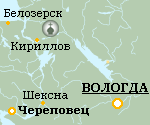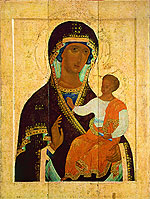 | ||
The St. Ferapont Belozero Monastery. The Virgin Nativity CathedralThe first stone building in Belozero region  Search | ||
 |
|
The St. Ferapont Belozero (Ferapontov Belozersky) Monastery. The Cathedral of the Virgin Nativity. 1502
 The Resurrection – Descent to the Underworld. Dionisy and his studio |
The St. Ferapont Belozero Monastery emerged at Belozero after St. Cyril Belozero (Kirillo-Belozersky) Monastery in the 15th century. It was founded by St. Ferapont, a friend and associate of St. Cyril of Belozero.
For 400 years the St. Ferapont Monastery was one of the most prominent cultural, religious and educational centres in Belozero region.
Along with the St. Cyril Belozero Monastery it became a favoured place of worship and of endowment for many members of the Russian nobility such as Andrei and Mikhail Mozhaisky, Vassily III, Ivan IV etc. Eminent hierarchs of the Russian Church, namely Archbishop of Rostov and Yaroslavl Joasaphus (Obolensky), Bishop of Perm and Vologda Philotheus, Bishop of Suzdal Ferapont came out of this monastery and actively participated in the life of the country at the turn of the 15th and 16th centuries.
At the same time, major religious figures who attempted to assert the superiority of church over state (Metropolitan Spiridon-Savva, Patriarch Nikon) were exiled here. Book calligraphers Martinian, Spiridon, Paisy, Matthew, Efrosyn as well as icon painter Dionisy worked here at the beginning of the 16th century.
 John the Baptist. Dionisy and his studio |
The first stone cathedral of the Nativity of the Virgin was built under Ferapont in 1409. In 1499, a stone cathedral was erected on its site by a Rostov architect. It is of special significance for Russian and world culture because its interior was painted by Dionisy and his sons from August 6 to September 1502 as it was attested in the inscription on the northern door soffit of the cathedral: “in the year of 7010, on August 6, the day of the Transfiguration of Jesus Christ, the wall painting of the church started and was finished 2 months later on September 8, the day of the Nativity of the Mother of God under the Grand Prince of All Rus Ivan Vassilievich and the Grand Prince of All Rus Vassily Ivanovich and Archbishop Tikhon. It was made by the icon painter Dionisy with his sons”.
The frescoes of the Virgin Nativity Cathedral are the only extant frescoes by Dionisy, the outstanding representative of the Moscow icon painting school of the turn of the 15th and 16th centuries. The wall-painting consists of 300 compositions and occupies 600 sq m.
 Saint Paul, the Apostle. Dionisy and studio |
In addition to the frescoes, there survived almost all icons of the Deesis and Prophets tiers as well two icons of the Sovereign tier of the St. Ferapont Belozero Monastery: the Hodegetria and The Resurrection of Christ (both are in the Russian State Museum).
Out of the seventeen icons of the Ferapont Deesis six icon panels: the Mother of God, John the Baptist, Archangel Michael, Apostle Peter, Apostle Paul and Demetrios of Soluncia are exhibited in the Tretyakov Gallery; five: Archangel Gabriel, Gregory the Theologian, John Chrysostom, George, Simeon Stolpnik are in the Russian Museum; four: Vassily the Great, Apostle Andrew, Apostle John the Evangelist, Nicholas the Miracle Worker, Daniil Stolpnik are in the Kirillov Museum. The seventeenth icon which is the main Deesis icon of the Saviour with Forces has not survived.
Most likely, the frescoes and icons of the St. Ferapont Belozero Monastery were the last major works by Dionisy. Among the monuments of Moscow art of the turn of the 15th and 16th centuries this ensemble is unique.
It has all typical features of the painting ‘mainstream’ of the capital as well as of Dionisy’s particular artistic style. It is an integral and perfect embodiment of his art.
His icon images possess organic plenitude, internal integrity and spiritual contemplation characteristic of the mystical experience of his great predecessors. Simultaneously, Dionisy managed to convey the spiritual revival of public life at the end of the 15th century and to influence the Weltanschauung of his contemporaries.
Experts know of around ten cathedrals whose walls were painted by Dionisy. Some of the painter’s works are lost for good; some have been preserved by restorers
Only the wall painting of the Virgin Nativity Cathedral of the St. Ferapont Belozero Monastery has survived in full and intact |
|
According to historical documents, the following works of Dionisy (the dates indicate the year of their painting) are known:
 The Holy Virgin Hodegetria. Dionisy and his studio |
See also:St. Ferapont of Mozhaisk (Belozero), Miracle-worker from Luzhki |
|
|
 |
SUPPORTING WITH:
| |||||||||||||








